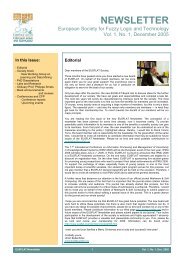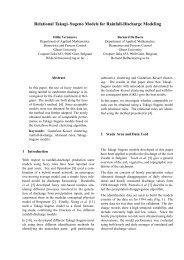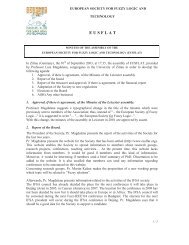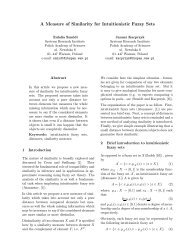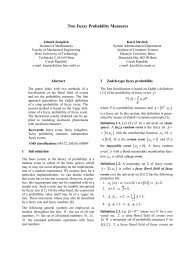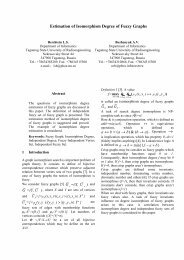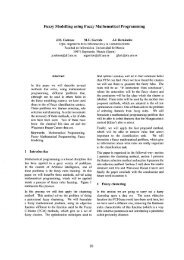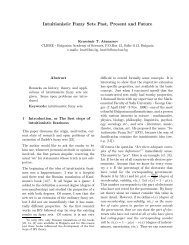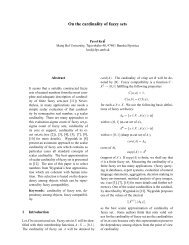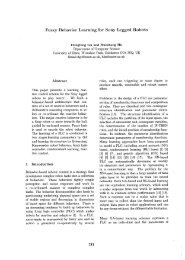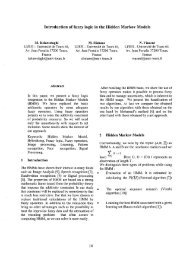Distances and orderings in a family of intuitionistic fuzzy ... - EUSFLAT
Distances and orderings in a family of intuitionistic fuzzy ... - EUSFLAT
Distances and orderings in a family of intuitionistic fuzzy ... - EUSFLAT
You also want an ePaper? Increase the reach of your titles
YUMPU automatically turns print PDFs into web optimized ePapers that Google loves.
<strong>Distances</strong> <strong>and</strong> <strong>order<strong>in</strong>gs</strong> <strong>in</strong> a <strong>family</strong> <strong>of</strong> <strong>in</strong>tuitionistic <strong>fuzzy</strong> numbers<br />
Abstract<br />
Two families <strong>of</strong> metrics <strong>in</strong> space <strong>of</strong> <strong>in</strong>tuitionistic<br />
<strong>fuzzy</strong> numbers are considered. A<br />
method <strong>of</strong> rank<strong>in</strong>g <strong>in</strong>tuitionistic <strong>fuzzy</strong> numbers<br />
based on these metrics is also suggested<br />
<strong>and</strong> <strong>in</strong>vesigated.<br />
Keywords: <strong>in</strong>tuitionistic <strong>fuzzy</strong> numbers,<br />
metrics, rank<strong>in</strong>g methods, expected value.<br />
1 Introduction<br />
A membership function <strong>of</strong> a classical <strong>fuzzy</strong> set assigns<br />
to each element <strong>of</strong> the universe <strong>of</strong> discourse a<br />
number from the unit <strong>in</strong>terval to <strong>in</strong>dicate the degree<br />
<strong>of</strong> belong<strong>in</strong>gness to the set under consideration. The<br />
degree <strong>of</strong> nonbelong<strong>in</strong>gness is just automatically the<br />
complement to 1 <strong>of</strong> the membership degree. However,<br />
a human be<strong>in</strong>g who expresses the degree <strong>of</strong> membership<br />
<strong>of</strong> given element <strong>in</strong> a <strong>fuzzy</strong> set very <strong>of</strong>ten does<br />
not express correspond<strong>in</strong>g degree <strong>of</strong> nonmembership<br />
as the complement to 1. This reflects a well known<br />
psychological fact that the l<strong>in</strong>guistic negation not always<br />
identifies with logical negation. Thus Atanassov<br />
[1] <strong>in</strong>troduced the concept <strong>of</strong> an <strong>in</strong>tuitionistic <strong>fuzzy</strong><br />
set which is characterized by two functions express<strong>in</strong>g<br />
the degree <strong>of</strong> belong<strong>in</strong>gness <strong>and</strong> the degree <strong>of</strong> nonbelong<strong>in</strong>gness,<br />
respectively. This idea, which is a natural<br />
generalization <strong>of</strong> usual <strong>fuzzy</strong> set, seems to be useful<br />
<strong>in</strong> model<strong>in</strong>g many real life situations.<br />
Rank<strong>in</strong>g <strong>fuzzy</strong> numbers is one <strong>of</strong> the fundamental<br />
problems <strong>of</strong> <strong>fuzzy</strong> arithmetic <strong>and</strong> <strong>fuzzy</strong> decision mak<strong>in</strong>g.<br />
It is due to the fact that <strong>fuzzy</strong> numbers are not<br />
l<strong>in</strong>early ordered. This problem is also important <strong>in</strong><br />
the case <strong>of</strong> <strong>in</strong>tuitionistic <strong>fuzzy</strong> numbers. In this paper<br />
Przemysław Grzegorzewski<br />
Systems Research Institute,<br />
Polish Academy <strong>of</strong> Sciences<br />
Newelska 6, 01-447 Warsaw, Pol<strong>and</strong><br />
pgrzeg@ibspan.waw.pl<br />
we propose <strong>and</strong> <strong>in</strong>vestigate two families <strong>of</strong> metrics <strong>in</strong><br />
space <strong>of</strong> <strong>in</strong>tuitionistic <strong>fuzzy</strong> numbers. Then we suggest<br />
a method <strong>of</strong> rank<strong>in</strong>g <strong>in</strong>tuitionistic <strong>fuzzy</strong> numbers<br />
based on these metrics.<br />
2 Basic notions<br />
Let X denote a universe <strong>of</strong> discourse. Then an <strong>in</strong>tuitionistic<br />
<strong>fuzzy</strong> set A <strong>in</strong> X (see [1], [2]) is a set <strong>of</strong> ordered<br />
triples<br />
A = {〈x,µA(x),νA(x)〉 : x ∈ X}, (1)<br />
where µA,νA : X → [0,1] are functions such that<br />
0 ≤ µA(x) + νA(x) ≤ 1 ∀x ∈ X. (2)<br />
For each x the numbers µA(x) <strong>and</strong> νA(x) represent the<br />
degree <strong>of</strong> membership <strong>and</strong> degree <strong>of</strong> nonmembership<br />
<strong>of</strong> the element x ∈ X to A ⊂ X, respectively. For each<br />
element x ∈ X we can compute the so-called, the <strong>in</strong>tuitionistic<br />
<strong>fuzzy</strong> <strong>in</strong>dex <strong>of</strong> x <strong>in</strong> A def<strong>in</strong>ed as follows<br />
πA(x) = 1 − µA(x) − νA(x). (3)<br />
Of course, a <strong>fuzzy</strong> set is a particular case <strong>of</strong> the <strong>in</strong>tuitionistic<br />
<strong>fuzzy</strong> set with νA(x) = 1 − µA(x).<br />
Atanassov has also def<strong>in</strong>ed two k<strong>in</strong>ds <strong>of</strong> α−cuts for<br />
<strong>in</strong>tuitionistic <strong>fuzzy</strong> sets. Namely<br />
Aα = {x ∈ X : µA(x) ≥ α}, (4)<br />
A α = {x ∈ X : νA(x) ≤ α}. (5)<br />
S<strong>in</strong>ce from now on we will restrict our consideration<br />
to <strong>in</strong>tuitionistic <strong>fuzzy</strong> numbers, henceforth our universe<br />
<strong>of</strong> discourse would be the real l<strong>in</strong>e, i.e. X = R .<br />
We def<strong>in</strong>e an <strong>in</strong>tuitionistic <strong>fuzzy</strong> number as follows<br />
(see [7]):
Def<strong>in</strong>ition 1 An <strong>in</strong>tuitionistic <strong>fuzzy</strong> subset A =<br />
{〈x,µA(x),νA(x)〉 : x ∈ R } <strong>of</strong> the real l<strong>in</strong>e is called<br />
an <strong>in</strong>tuitionistic <strong>fuzzy</strong> number if<br />
(a) A is if-normal (i.e. there exist at least two po<strong>in</strong>ts<br />
x0,x1 ∈ X such that µA(x0) = 1 <strong>and</strong> νA(x1) = 1),<br />
(b) A is if-convex (i.e. its membership function µ is<br />
<strong>fuzzy</strong> convex <strong>and</strong> its nonmembership function is <strong>fuzzy</strong><br />
concave),<br />
(c) µA is upper semicont<strong>in</strong>uous <strong>and</strong> νA is lower<br />
semicont<strong>in</strong>uous,<br />
(d) suppA = cl ({x ∈ X : νA(x) < 1}) is bounded.<br />
From the def<strong>in</strong>ition given above we get at once that<br />
for any <strong>in</strong>tuitionistic <strong>fuzzy</strong> number A there exist eight<br />
numbers a1,a2,a3,a4,b1,b2,b3,b4 ∈ R such that b1 ≤<br />
a1 ≤ b2 ≤ a2 ≤ a3 ≤ b3 ≤ a4 ≤ b4 <strong>and</strong> four functions<br />
fA,gA,hA,kA : R → [0,1], called the sides <strong>of</strong> a <strong>fuzzy</strong><br />
number, where fA <strong>and</strong> kA are nondecreas<strong>in</strong>g <strong>and</strong> gA<br />
<strong>and</strong> hA are non<strong>in</strong>creas<strong>in</strong>g, such that we can describe a<br />
membership function µA <strong>in</strong> a form<br />
⎧<br />
⎪⎨<br />
µA(x) =<br />
⎪⎩<br />
0 if x < a1<br />
fA(x) if a1 ≤ x < a2<br />
1 if a2 ≤ x ≤ a3<br />
gA(x) if a3 < x ≤ a4<br />
0 if a4 < x.<br />
, (6)<br />
while a nonmembership function νA has a follow<strong>in</strong>g<br />
form<br />
⎧<br />
⎪⎨<br />
1<br />
hA(x)<br />
if<br />
if<br />
x < b1<br />
b1 ≤ x < b2<br />
νA(x) =<br />
⎪⎩<br />
0<br />
kA(x)<br />
1<br />
if<br />
if<br />
if<br />
b2 ≤ x ≤ b3<br />
b3 < x ≤ b4<br />
b4 < x.<br />
(7)<br />
It is worth not<strong>in</strong>g that each <strong>in</strong>tuitionistic <strong>fuzzy</strong> number<br />
A = {〈x,µA(x),νA(x)〉 : x ∈ R } is a conjunction <strong>of</strong><br />
two <strong>fuzzy</strong> numbers: A + with a membership function<br />
µA +(x) = µA(x) <strong>and</strong> A − with a membership function<br />
µA −(x) = 1− νA(x). It is seen that suppA + ⊆ suppA − .<br />
A useful tool for deal<strong>in</strong>g with <strong>fuzzy</strong> numbers are their<br />
α−cuts. Every α−cut <strong>of</strong> a <strong>fuzzy</strong> number is a closed<br />
<strong>in</strong>terval <strong>and</strong> a <strong>family</strong> <strong>of</strong> such <strong>in</strong>tervals describes completely<br />
a <strong>fuzzy</strong> number under study. In the case <strong>of</strong><br />
<strong>in</strong>tuitionistic <strong>fuzzy</strong> numbers it is convenient to dist<strong>in</strong>guish<br />
follow<strong>in</strong>g α−cuts: (A + )α <strong>and</strong> (A − )α. It is easily<br />
seen that<br />
(A + )α = {x ∈ X : µA(x) ≥ α} = Aα, (8)<br />
(A − )α = {x ∈ X : 1 − νA(x) ≥ α} (9)<br />
= {x ∈ X : νA(x) ≤ 1 − α} = A 1−α .<br />
Accord<strong>in</strong>g to the def<strong>in</strong>ition it is seen at once that<br />
every α−cut (A + )α or (A− )α is a closed <strong>in</strong>terval.<br />
Hence we have (A + )α = [A + L (α),A+ U (α)] <strong>and</strong> (A− )α =<br />
[A − L (α),A− U (α)], respectively, where<br />
A + L (α) = <strong>in</strong>f{x ∈ R : µA(x) ≥ α},<br />
A + U (α) = sup{x ∈ R : µA(x) ≥ α},<br />
A − L (α) = <strong>in</strong>f{x ∈ R : νA(x) ≤ 1 − α},<br />
A − U (α) = sup{x ∈ R : νA(x) ≤ 1 − α}.<br />
(10)<br />
If the sides <strong>of</strong> the <strong>fuzzy</strong> number A are strictly monotone<br />
then by (6) <strong>and</strong> (7) one can see easily that A + L (α),<br />
A + U (α), A−L (α) <strong>and</strong> A− U (α) are <strong>in</strong>verse functions <strong>of</strong><br />
fA, gA, hA <strong>and</strong> kA, respectively. In general, we may<br />
adopt the convention that f −1<br />
A (α) = A+ L (α), g−1<br />
A (α) =<br />
A + U (α), h−1<br />
A (α) = A−L (α) <strong>and</strong> k−1<br />
A (α) = A− U (α).<br />
3 <strong>Distances</strong> between <strong>in</strong>tuitionistic <strong>fuzzy</strong><br />
numbers<br />
Various methods for measur<strong>in</strong>g distances between <strong>in</strong>tuitionistic<br />
<strong>fuzzy</strong> sets are considered <strong>in</strong> the literature<br />
(see [1], [5], [6], [9]). Below we suggest two families<br />
<strong>of</strong> metrics that seem to be useful for measur<strong>in</strong>g distances<br />
between <strong>in</strong>tuitionistic <strong>fuzzy</strong> numbers. We get<br />
Def<strong>in</strong>ition 2 The dp(A,B) distance, <strong>in</strong>dexed by a parameter<br />
1 ≤ p ≤ ∞, for any two <strong>in</strong>tuitionistic <strong>fuzzy</strong><br />
numbers A = {〈x,µA(x),νA(x)〉 : x ∈ R } <strong>and</strong> B =<br />
{〈x,µB(x),νB(x)〉 : x ∈ R } is given by<br />
dp(A,B) =<br />
<br />
1<br />
4<br />
+ 1<br />
4<br />
+ 1<br />
4<br />
+ 1<br />
4<br />
1<br />
0<br />
1<br />
0<br />
1<br />
0<br />
1<br />
0<br />
<br />
+<br />
A L (α) − B + L (α) p dα<br />
<br />
+<br />
A U (α) − B + U (α) p dα (11)<br />
<br />
A − L (α) − B−L (α) p dα<br />
<br />
−<br />
AU (α) − B − U (α) p dα<br />
1/p<br />
for 1 ≤ p < ∞ <strong>and</strong><br />
dp(A,B) = 1<br />
4 sup<br />
<br />
+<br />
A L (α) − B<br />
0
Def<strong>in</strong>ition 3 The ρp(A,B) distance, <strong>in</strong>dexed by a parameter<br />
1 ≤ p ≤ ∞, for any two <strong>in</strong>tuitionistic <strong>fuzzy</strong><br />
numbers A = {〈x,µA(x),νA(x)〉 : x ∈ R } <strong>and</strong> B =<br />
{〈x,µB(x),νB(x)〉 : x ∈ R } is given by<br />
ρp(A,B) =<br />
⎧<br />
⎨<br />
max<br />
⎩<br />
1<br />
p<br />
p<br />
0<br />
1<br />
p<br />
0<br />
1<br />
0<br />
1<br />
p<br />
0<br />
<br />
A + L (α) − B + L (α) p dα,<br />
<br />
A + U (α) − B+ U (α) p dα, (13)<br />
<br />
−<br />
AL (α) − B − L (α) p dα,<br />
<br />
A − U (α) − B− U (α) p ⎫<br />
⎬<br />
dα<br />
⎭<br />
for 1 ≤ p < ∞ <strong>and</strong><br />
ρp(A,B) =<br />
<br />
<br />
max sup A<br />
0
is called the order respect to the upper horizon H.<br />
Of course, us<strong>in</strong>g different metrics, e.g. dp or ρp given<br />
above, we may obta<strong>in</strong> different orders. Anyway, the<br />
follow<strong>in</strong>g theorem holds<br />
Theorem 3 Let H ∈ IFN. Then HL(H) is quasiordered<br />
by the relation ≻L, while HU(H) is quasiordered<br />
by the relation ≻U. Moreover, both relations<br />
≻L<strong>and</strong> ≻U are connected.<br />
It should be noticed that both relations ≻L <strong>and</strong> ≻U<br />
are not antisymmetric <strong>and</strong> hence they are only quasiorder<strong>in</strong>g<br />
relations, not order<strong>in</strong>g relations. However,<br />
every quasi-order<strong>in</strong>g determ<strong>in</strong>es an equivalence relation<br />
<strong>and</strong> an order<strong>in</strong>g relation (on equivalence classes)<br />
<strong>in</strong> a natural way. Therefore the last theorem is <strong>of</strong> great<br />
importance s<strong>in</strong>ce it makes possible to rank any sub<strong>family</strong><br />
<strong>of</strong> <strong>in</strong>tuitionistic <strong>fuzzy</strong> numbers which is lowerdom<strong>in</strong>ated<br />
or upper-dom<strong>in</strong>ated that is very common<br />
<strong>in</strong> practical applications.<br />
Now we show some properties <strong>of</strong> the proposed quasi<strong>order<strong>in</strong>gs</strong><br />
based on the metrics <strong>in</strong>troduced on Sec. 3.<br />
Namely<br />
Theorem 4 The quasi-order ≻L with respect to the<br />
lower horizon, based on the metric d1 (i.e. dp for<br />
p = 1), does not depend on the choice <strong>of</strong> the lower<br />
horizon. Similarly, the quasi-order ≻U with respect<br />
to the upper horizon, based on the metric d1, does not<br />
depend on the choice <strong>of</strong> the upper horizon.<br />
Theorem 5 The quasi-orders ≻L with respect to the<br />
lower horizon, based on the metric d∞, ρ1 <strong>and</strong> ρ∞, do<br />
not depend on the choice <strong>of</strong> the lower horizon, provided<br />
that the horizon is a crisp number. Similarly,<br />
the quasi-orders ≻U with respect to the upper horizon,<br />
based on the metric d∞, ρ1 <strong>and</strong> ρ∞, do not depend<br />
on the choice <strong>of</strong> the upper horizon, provided that the<br />
horizon is a crisp number.<br />
5 Expected value <strong>and</strong> <strong>order<strong>in</strong>gs</strong><br />
The expected <strong>in</strong>terval <strong>of</strong> an <strong>in</strong>tuitionistic <strong>fuzzy</strong> number<br />
A = {〈x,µA(x),νA(x)〉 : x ∈ R } is a crisp <strong>in</strong>terval<br />
EI(A) given by (see [7])<br />
<br />
EI(A) = E∗(A), E ∗ <br />
(A)<br />
(19)<br />
where<br />
E∗(A) = b1+a2<br />
2<br />
E ∗ (A) = a3+b4<br />
2<br />
b1<br />
b2<br />
1 + 2 hA(x)dx − 1a1<br />
a2<br />
2 fA(x)dx,<br />
a3<br />
a4<br />
1 + 2 gA(x)dx − 1b3<br />
b4<br />
2 kA(x)dx.<br />
(20)<br />
As <strong>in</strong> the case <strong>of</strong> the classical <strong>fuzzy</strong> sets we will def<strong>in</strong>e<br />
the expected value <strong>of</strong> <strong>in</strong>tuitionistic <strong>fuzzy</strong> number as<br />
follows (compare [3], [8]):<br />
Def<strong>in</strong>ition 8 The expected value EV (A) <strong>of</strong> an <strong>in</strong>tuitionistic<br />
<strong>fuzzy</strong> number A = {〈x,µA(x),νA(x)〉 : x ∈ R }<br />
is the center <strong>of</strong> the expected <strong>in</strong>terval <strong>of</strong> that <strong>in</strong>tuitionistic<br />
<strong>fuzzy</strong> number, i.e.<br />
A follow<strong>in</strong>g theorem holds<br />
EV (A) = E∗(A) + E ∗ (A)<br />
. (21)<br />
2<br />
Theorem 6 Let ≻L <strong>and</strong> ≻U denote the quasi-order<br />
with respect to the lower <strong>and</strong> upper horizon, respectively,<br />
based on the metric d1 (i.e. dp for p = 1). Then<br />
for any A,B ∈ IFN we get<br />
<strong>and</strong><br />
A ≻L B ⇐⇒ EV (A) ≥ EV (B) (22)<br />
A ≻U B ⇐⇒ EV (A) ≥ EV (B). (23)<br />
As a natural consequence <strong>of</strong> Th. 4 <strong>and</strong> Th. 6 we get<br />
Corollary Quasi-order ≻L <strong>and</strong> ≻U with respect to the<br />
lower <strong>and</strong> upper horizon, respectively, based on the<br />
metric d1, do not depend on the choice <strong>of</strong> any horizon.<br />
Moreover, these two quasi-orders are equivalent, i.e.<br />
6 Conclusions<br />
A ≻L B ⇐⇒ A ≻U B. (24)<br />
In this paper we have <strong>in</strong>troduced two families <strong>of</strong> metrics<br />
<strong>in</strong> a space <strong>of</strong> <strong>in</strong>tuitionistic <strong>fuzzy</strong> numbers. We<br />
have also proposed a method <strong>of</strong> rank<strong>in</strong>g <strong>in</strong>tuitionistic<br />
<strong>fuzzy</strong> numbers based on the suggested metrics <strong>and</strong><br />
considered some properties <strong>of</strong> these methods. Order<strong>in</strong>gs<br />
based on the metric d1 are <strong>of</strong> a special <strong>in</strong>terest<br />
because <strong>of</strong> the close relationship with the concept <strong>of</strong><br />
expected value <strong>of</strong> an <strong>in</strong>tuitionistic <strong>fuzzy</strong> number. It<br />
is worth not<strong>in</strong>g that these results are direct generalizations<br />
<strong>of</strong> the results obta<strong>in</strong>ed for the classical <strong>fuzzy</strong><br />
numbers.
References<br />
[1] Atanassov K. (1986), Intuitionistic <strong>fuzzy</strong> sets,<br />
Fuzzy Sets <strong>and</strong> Systems 20, 87–96.<br />
[2] Atanassov K. (1999), Intuitionistic Fuzzy Sets:<br />
Theory <strong>and</strong> Applications, Physica-Verlag.<br />
[3] Dubois D., Prade H. (1987), The mean value <strong>of</strong> a<br />
<strong>fuzzy</strong> number, Fuzzy Sets <strong>and</strong> Systems 24, 279–<br />
300.<br />
[4] Grzegorzewski P. (1998), Metrics <strong>and</strong> orders <strong>in</strong><br />
space <strong>of</strong> <strong>fuzzy</strong> numbers, Fuzzy Sets <strong>and</strong> Systems<br />
97, 83–94.<br />
[5] Grzegorzewski P. (2002), <strong>Distances</strong> between <strong>in</strong>tuitionistic<br />
<strong>fuzzy</strong> sets based on the Hausdorff metric,<br />
submitted.<br />
[6] Grzegorzewski P. (2003), The Hamm<strong>in</strong>g distance<br />
between <strong>in</strong>tuitionistic <strong>fuzzy</strong> sets, accepted for the<br />
Proceed<strong>in</strong>gs <strong>of</strong> the IFSA 2003 World Congress.<br />
[7] Grzegorzewski P. (2003), Intuitionistic <strong>fuzzy</strong> numbers,<br />
accepted for the Proceed<strong>in</strong>gs <strong>of</strong> the IFSA<br />
2003 World Congress.<br />
[8] Heilpern S. (1992), The expected value <strong>of</strong> a <strong>fuzzy</strong><br />
number, Fuzzy Sets <strong>and</strong> Systems 47, 81–86.<br />
[9] Szmidt E., Kacprzyk J. (1997), <strong>Distances</strong> between<br />
<strong>in</strong>tuitionistic <strong>fuzzy</strong> sets, Fuzzy Sets <strong>and</strong> Systems<br />
114, 505–518.



